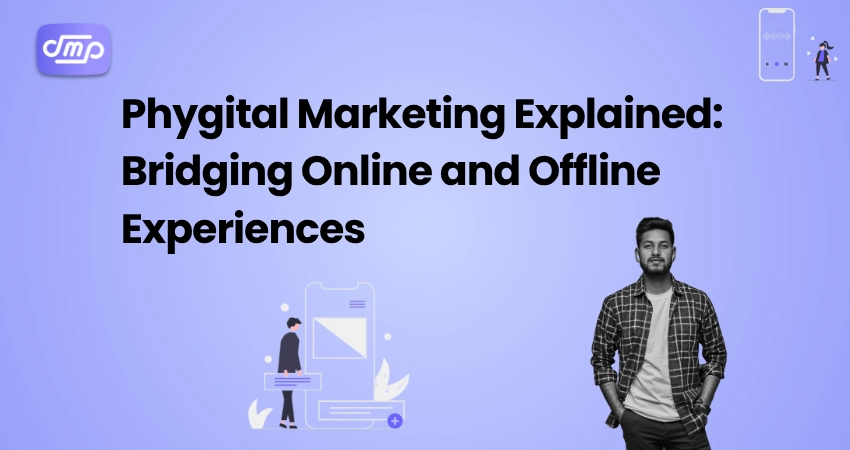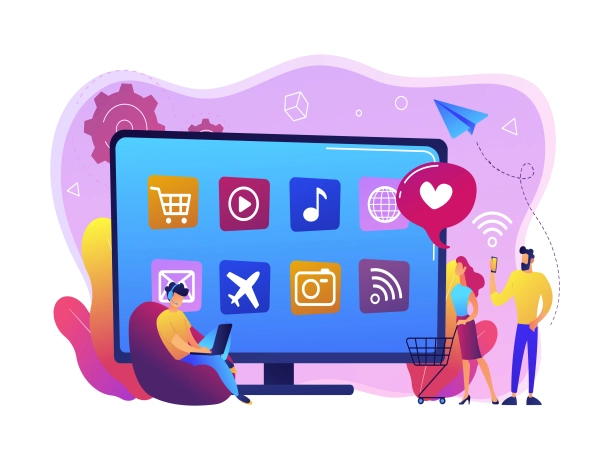
- June 13, 2025
- Digital Marketing, seo
- Digital Marketing
Table of Contents
Phygital Marketing combines physical and digital marketing methods to create seamless, interactive, and immersive customer experiences. It combines a brand’s visible presence in the real world (such as physical stores or events) with the power and reach of digital platforms (such as mobile applications, social media, or virtual try-ons) to engage customers across many touchpoints.
At its core, phygital marketing aims to bridge the gap between the online and offline worlds by ensuring that customers receive consistent messaging, personalized interactions, and seamless transitions between platforms—whether they’re browsing online, visiting a store, scanning a QR code, or interacting with a smart display.
Phygital marketing, which combines physical presence with digital technology, strives to:
- Improve customer engagement
- Improve data-driven personalization.
- Create memorable and real-time brand encounters.
It’s a modern approach that mirrors how people behave today, seamlessly transitioning between digital gadgets and real-world settings.
What is Phygital Marketing?
Phygital marketing is a technique that integrates physical and digital interactions to create cohesive, interactive, and personalized customer journeys. The term “phygital” is a combination of “physical” and “digital,” describing how brands today interact with customers in both in-store and online settings.
In today’s interconnected environment, customers no longer differentiate between online and offline encounters. They anticipate seamless transitions, such as viewing products on a website, checking in-store availability via an app, or scanning a QR code in-store to get further information. This type of coherent experience is made possible via physical marketing.
Key Features of Physical Marketing:
- Omnichannel Integration: Aligns various touchpoints such as websites, apps, retail, kiosks, and events.
- Personalization: Uses data from internet platforms to customize in-person experiences.
- Real-Time Engagement: Uses technology such as augmented reality, virtual reality, beacons, and the Internet of Things to improve physical interactions.
- Customer-Centric Approach: Concentrates on how and where the customer wants to interact, rather than merely the channel itself.
Real-life examples include a retail store employing smart mirrors to offer clothing based on internet purchasing history. QR codes in physical locations lead to immersive smartphone experiences. Attendees can utilize apps to interact with booths and vote in real time.
Phygital marketing is more than just a trend; it is a response to changing consumer expectations. As technology advances, organizations that implement physical tactics are better positioned to provide memorable, compelling, and relevant brand experiences.
Why Phygital Marketing Matters in 2025
In 2025, physical marketing will play an important role in defining how firms connect with their audiences. As customer behavior blurs the distinction between digital and physical encounters, firms must develop strategies that cater to both worlds concurrently. Phygital marketing is more than just a buzzword; it is a necessary progression to fulfill the expectations of today’s empowered, tech-savvy customers.
- Consumer expectations have evolved: Customers in 2025 want convenience, personalization, and consistency across all touchpoints. They expect a smooth, integrated experience whether they’re browsing the web, shopping, or utilizing mobile apps. Phygital marketing enables brands to do so by seamlessly connecting real-world and digital touchpoints in real time.
- Data-driven personalization: Phygital techniques allow brands to collect and analyze data from both online and offline habits. Businesses that analyze this data can provide highly tailored experiences, such as proposing products in-store based on internet search history or following up with digital offers following a physical visit.
- Improved customer engagement: Augmented reality (AR), NFC tags, and virtual fitting rooms are examples of interactive digital tools that enhance the experience of physical environments. Phygital marketing generates immersive, memorable experiences that attract attention, extend dwell time, and promote brand loyalty.
- Increased Conversions and ROI: By combining the immediacy of digital engagement with the trust-building power of real presence, physical marketing shortens the buying journey and boosts conversion rates. It enables marketers to capitalize on impulse purchases in physical settings while leveraging digital technologies to upsell or cross-sell in the moment.
- Competitive Differentiation: In a crowded market, businesses that use physical techniques stand out. Offering a cohesive customer journey that seamlessly transitions between the online and offline worlds promotes greater emotional ties and long-term loyalty.
Key Benefits of Phygital Marketing
Phygital marketing, a combination of physical and digital experiences, provides significant advantages for organizations seeking to remain relevant and competitive in 2025. By providing seamless, engaging, and personalized experiences across channels, it improves the consumer journey from discovery to purchase and beyond. Here are the main advantages of embracing physical marketing:
- A seamless omnichannel experience: Phygital marketing ensures uniformity over all consumer touchpoints. Whether a customer starts online and finishes in-store, or vice versa, the transition appears natural and seamless. This consistency boosts satisfaction and trustworthiness.
- Deeper customer engagement: Using digital technology such as AR, VR, QR codes, and smart sensors in physical surroundings promotes deeper engagement. These techniques make brand encounters more memorable and vivid, resulting in deeper emotional ties.
- Real-time personalization: Phygital marketing allows brands to personalize experiences based on real-time data. Businesses can provide tailored recommendations, discounts, and messaging to specific clients by combining their online and in-store browsing activities.
- Increased sales and conversions: Customers are more likely to convert when they are provided with a consistent and personalized experience. For example, scanning a product in-store to obtain more information or reviews might reassure and prompt rapid purchasing decisions.
- Improved data collection and insights: Integrating digital tools into real spaces delivers more detailed behavioral data. Businesses can monitor foot traffic, dwell time, engagement levels, and purchasing habits to inform better marketing strategies and product placements.
- Enhanced Brand Loyalty: Providing thoughtful and relevant experiences increases trust and loyalty. Customers who feel understood and valued throughout each conversation are more likely to return and recommend the firm.
- Increased competitive edge: In a saturated market, physical experiences help firms stand out. Retailers, restaurants, and service providers that use cutting-edge technology to improve in-person encounters are more likely to gain customer attention and loyalty.
Components of a Successful Phygital Strategy

Creating a successful physical marketing plan necessitates a careful combination of technology, analytics, and human-centered experiences. To successfully bridge the gap between physical and digital encounters, brands must include the following crucial components:
- Integrated Technology Ecosystem: Integrated technology is crucial to any physical experience. This includes:
Mobile apps for better in-store navigation or loyalty programs
QR codes and NFC tags can quickly provide product information or offers.
AR/VR experiences that bring objects or locations to life.
IoT devices for real-time tracking and personalized messages
These tools must be linked together to ensure smooth transitions between online and offline conversations.
- Unified Customer Data Platform (CDP): Data is what drives personalization. A unified CDP collects and analyzes customer interactions across physical and digital channels, which helps brands:
Understand the individual’s actions and preferences.
Customize content, offers, and communication.
Optimize future campaigns with insights.
Without unified data, it is practically impossible to create a truly connected physical experience.
- Personalization Engine: To create engaging experiences, personalization must extend beyond basic demographics. Brands should provide dynamic, behavior-based customisation through:
Making product recommendations based on both in-store and online activities.
Offer location-specific promotions or reminders.
Sending follow-ups after physical visits or exchanges
This keeps the experience relevant and interesting throughout all touchpoints.
- Seamless Omnichannel Integration: True physical success relies on breaking down silos. Marketing, sales, and customer service teams must work together to:
Maintain consistent messaging across all media.
Ensure inventories and pricing align.
Allow customers to switch between touchpoints (e.g., buy online and pick up in-store).
A seamless omnichannel experience fosters confidence and lowers friction throughout the consumer journey.
- Interactive Physical Environments: Physical environments should be digitally augmented to increase engagement. This may include:
Retailers use smart mirrors for virtual try-ons.
Touchscreen kiosks to browse products and place orders.
Digital signage for dynamic marketing and updates.
- Agile Feedback Loops: To continuously improve the physical experience, marketers must monitor performance and collect feedback. This includes:
In-store surveys and online reviews
Heatmaps and Foot Traffic Analysis
A/B test content or layouts across locales.
Regular analysis ensures that the plan remains in line with client expectations and shifting habits.
How to Get Started with Phygital Marketing

Beginning with physical marketing requires creating a strategy that combines digital convenience with in-person interaction. Here’s how to get started:
- Understand Your Customer’s Journey: Plan out how your clients will connect with your brand both online and offline.
- Invest in the right technology: Start with scalable technologies such as QR codes, NFC, mobile apps, and in-store iPads. These do not require a large investment but can significantly increase interaction.
- Unify your data: Use a Customer Data Platform (CDP) to collect information from both online and offline resources. This enables more personalized and consistent communications. Begin by piloting physical efforts in a few areas or campaigns before scaling up. Before launching, track interaction, gather feedback, and fine-tune your strategy.
- Focus on seamless integration: Ensure that your teams (marketing, sales, and support) and systems are in sync to deliver a consistent brand experience across all channels.
By carefully integrating physical and digital aspects, your company can create immersive, personalized, and memorable consumer trips that foster long-term loyalty.
Conclusion
Physical marketing is no longer a trend; it will be a need by 2025. As customers seek more personalized, frictionless, and engaging experiences, organizations must integrate the digital and physical touchpoints. By combining technology and real-world interactions, brands may improve consumer satisfaction, help in web development promote deeper engagement, and differentiate themselves in a competitive market. Embracing physical techniques not only helps to future-proof your marketing efforts, but it also ensures that you reach clients where they are, both online and offline. Now is the moment to evolve and create really integrated brand experiences.











